
Azanus ubaldus, the bright babul blue, desert babul blue, or velvet-spotted blue, is a small butterfly found in India, the Middle East and Africa that belongs to the lycaenids or blues family.
Aloeides nollothi, the Nolloth's copper, is a species of butterfly in the family Lycaenidae. It is found in Namibia and the Northern Cape province of South Africa.
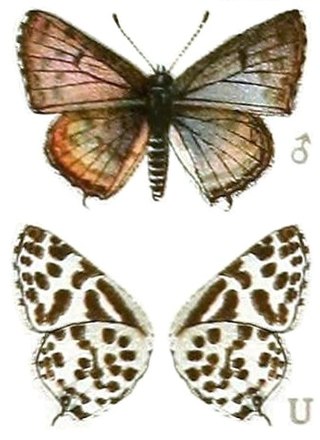
Zintha is a butterfly genus in the family Lycaenidae. It is monotypic, with the only species being Zintha hintza, the blue-eyed Pierrot, blue pied Pierrot or Hintza blue. The pied Pierrots proper are the closely related genus Tuxentius, however, and like Zintha they were formerly included in Castalius.

Colotis euippe is a butterfly of the family Pieridae that is found in the Afrotropical realm.

Sevenia boisduvali, the Boisduval's tree nymph, is a butterfly in the family Nymphalidae. There are four subspecies; all native to Africa.
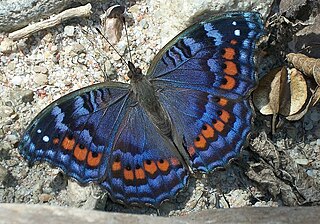
Precis octavia, the gaudy commodore, is a species of butterfly in the family Nymphalidae. It is native to Africa.

Acraea encedon, the common acraea, white-barred acraea or encedon acraea, is a butterfly of the family Nymphalidae. It is found in sub-Saharan Africa and south-western Arabia. It is one of the species of Acraea sometimes separated in Telchinia.

Acraea cabira, the yellow-banded acraea, is a butterfly of the family Nymphalidae that is native to Africa.
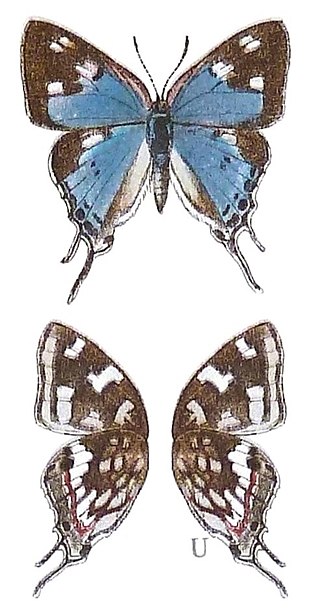
Stugeta subinfuscata, the dusky sapphire, is a butterfly of the family Lycaenidae. It is found in southern Africa.
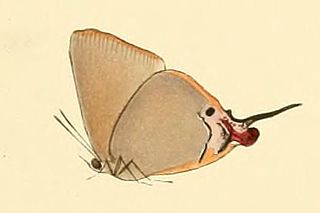
Myrina dermaptera, the lesser fig-tree blue or scarce fig-tree blue, is a butterfly of the family Lycaenidae. It is found in Sub-Saharan Africa, southern Arabia and northern Oman.
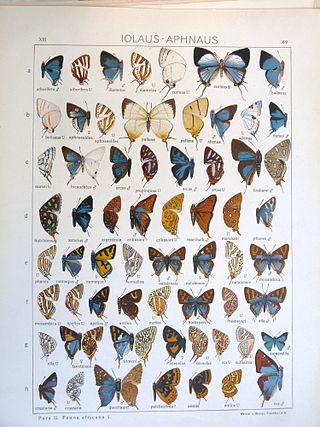
Cigaritis phanes, the silvery bar, is a butterfly of the family Lycaenidae. It is found in south-west Africa, including Botswana, Zimbabwe and South Africa. In South Africa it is found from north-western KwaZulu-Natal to the northern part of the Free State, Gauteng, Mpumalanga, Limpopo, North West and Northern Cape.

Argyraspodes is a butterfly genus in the family Lycaenidae. It is monotypic containing only the species Argyraspodes argyraspis, the warrior silver-spotted copper, which is found in South Africa, in the Western and Eastern Cape, Free State and Northern Cape.
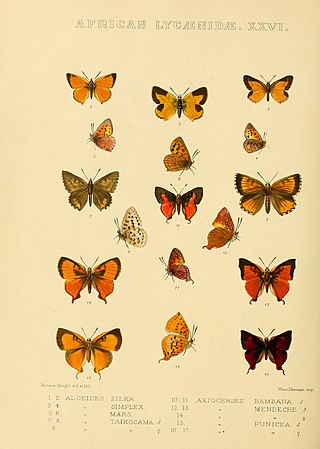
Aloeides simplex, the dune copper, is a butterfly of the family Lycaenidae. It is found in South Africa, where it is known from sandy areas in the Kalahari and arid savannah, the red dunes from Kuruman, Hotazel and further west in the Northern Cape.
Aloeides depicta, the depicta copper, is a butterfly of the family Lycaenidae. It is found in South Africa, where it is known from fynbos and Nama Karoo along the mountains from Matjiesfontein to Gydo Mountain and the Eastern Cape.

Aloeides damarensis, the Damara copper, is a butterfly of the family Lycaenidae from South Africa.
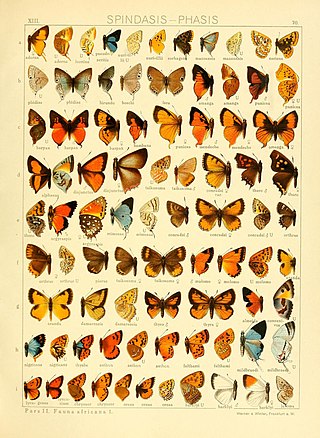
Aloeides molomo, the molomo copper, is a butterfly of the family Lycaenidae. It is found in southern Africa.

Chrysoritis thysbe, the opal copper or common opal, is a butterfly of the family Lycaenidae. It is found in South Africa.
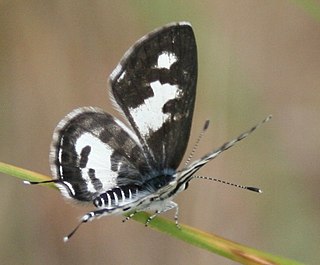
Tuxentius calice, the white pie, is a butterfly of the family Lycaenidae. It is found in Africa southwards of the equator.
Tuxentius hesperis, the western pie, is a butterfly of the family Lycaenidae. It is found in South Africa, where it is only known from Groblershoop and Vioolsdrif and along the banks of the Orange River in the Northern Cape.

Appias sabina, the Sabine albatross or albatross white, is a butterfly of the family Pieridae. It is found in Africa. The habitat consists of forests.



















